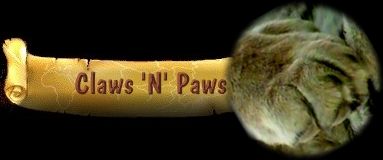
Claws, Paws & Pug Marks - Page 1&2: Claws| 3&4: Pug Marks | 5&6: Declawing

Claws, Paws & Pug Marks -
Page 1&2: Claws|
3&4: Pug Marks
| 5&6: Declawing
|
The following information is designed, not only to educate on the use of declawing in exotic felids, but also to assist owners of domestic cats in making a decision on this procedure. This article does not constitute support for declawing by the owner of this Web site. At one point in time the Webmistress owned seven cats and declawing was never a consideration. However, this site has a firm policy of introducing the facts and allowing the viewer to make their own informed decisions. Since the procedure is a frequent one, the topic seems applicable to this site. Please note that this article and accompanying images may be disturbing to some viewers. It is a general introductory article and precise information should be gained from your veterinarian. Onychectomy or declawing:De-clawing (veterinary or clinical term: onychectomy) is an operation carried out both in domestic and exotic felids. In big cats it is most common among private owners, but is also used in some performing cats and occasionally by zoos, particularly in Asia. In some situations de-clawing may be accompanied by filing down and filling of canine teeth, tendon cutting to prevent a tiger jumping up, and drugging to keep the animal calm when they pose with visitors for the cameras. |
In the United States, declawing of domestic cats is common though many veterinarians prefer to suggest other options to the owners. When performed on domestic cats it is usual to remove only the front claws. Rear claw removal is considered unnecessary. With these intact a domestic cat still has some degree of defence and can climb trees. Safety is usually given as justification for declawing of big cats. Supporters claim it prevents injury to owners, veterinarians, other animals, and even to the cat itself. All of these claims are also applied to domestic cats, along with the statement that it protects furniture. The fact remains that declawing is purely a side effect of man's desire to keep animals in captivity. The declawing procedure:Note: where there is a blue number beside a word, the meaning can be found at the base of this page. Firstly the paws are cleansed; in long-haired cats they may be shaved or clipped. General anaesthetic should always be used. To prevent excessive bleeding an assistant applies pressure to the brachial artery. Where an assistant is not available a tourniquet may be applied. A guillotine-type nail trimmer or blade is employed to carry out the operation. The only way to ensure no further growth occurs is to remove all of the ungual¹ crest and distal² phalanx³. In simple terms this means the removal of the claw; the cells deep at the base which are responsible for growth, and a portion of bone. The equivalent operation on a human would involve removal of the fingers at the last knuckle. Following surgery, paws are bandaged for 18-24 hours and the cat may be kept tranquilized to reduce the chances of haemorrhage and annoying of bandages, causing early removal. Recovery is best in young cats and it is suggested the operation be carried out when the cat is neutered, so removing the need for unnecessary anaesthesia. ¹
Having,
resembling, or pertaining to a hoof, claw or nail. ²
Relatively
remote from the main portion of the body. ³ One of the bones articulating with the joints of the fingers or toes. |
|
Claws, Paws & Pug Marks - Page 1&2: Claws| 3&4: Pug Marks | 5&6: Declawing Taxonomy
| Whiskers
| Hearing & Ear Spots | Eyesight
| Smell | Teeth
| Communication | Flehman
| Genetics | |
|
Photography
With Thanks To The Auckland
S.P.C.A. |